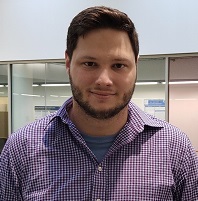Diffractive Optics for Augmented Reality
This webinar is hosted By: Display Technology Technical Group
09 August 2024 8:00 - 9:30
Eastern Daylight/Summer Time (US & Canada) (UTC -04:00)Join the Display Technology Technical Group for a virtual panel discussion covering diffractive optics applied in augmented reality displays, including the fabrication method, diffractive system design, and spatial light modulation. The session will also explore the advantages and challenges of incorporating diffractive optics in the optical design of augmented reality.
The panel will feature presentations from Andreas Georgiou, Reality Optics, Cheng Zheng, Massachusetts Institute of Technology, Edward Buckley, Swave Photonics, and Daniel Nikolov, University of Rochester. Each talk will be around 15 minutes, and a discussion session will follow the talks.
About Our Speakers
Andreas Georgiou
Reality Optics
Andreas Georgiou is an Independent Consultant with Reality Optics Ltd, and he is particularly interested in computational problems in ray and wave optical design. He worked in diffractive optics for over two decades and over a decade in Mixed Reality optics. Andreas enjoys making new ideas into operating prototypes by combining physics, mathematics, engineering, and software. He particularly likes working with head-mounted displays, three-dimensional displays, sensors, and everything unusual with lenses and gratings inside. Before his current position, Andreas worked with many product groups at Microsoft (Surface, HoloLens, Azure, and Kinect), developed micro-confocal endoscopes for surgery, designed space instruments for Mars, and created the first genuinely holographic display. He obtained his PhD in Optics from the University of Cambridge. He is also an Engineering Research Fellow at Robinson College, Cambridge, where he continues to teach. He has over 30 patents and over 20 peer-reviewed publications on head-mounted displays, data storage, holographic displays, and data transmission.
MTF, Efficiency and Uniformity in Diffractive AR Waveguides
Cheng Zheng
Massachusetts Institute of Technology
Cheng Zheng received her Ph.D. degree at MIT Mechanical Engineering in 2024, mentored by Prof. Peter T. C. So, with her research centered on computational imaging and optics. She aims to create advanced imaging and optical systems that intelligently and informatively interact with the physical world. Her work navigates the challenge of connecting academic progress in computational cameras to real-world applications, utilizing artificial intelligence, digital fabrication, and differentiable optics.
Neural Lithography: Close the Design to Manufacturing Gap in Computational Optics with a 'Real2Sim' Learned Photolithography Simulator
Edward Buckley
Swave Photonics
Dr. Edward Buckley is Vice President, Augmented Reality Solutions, of Swave Photonics, based in Leuven, Belgium and Silicon Valley. He is a recognized display expert, having taken numerous novel display technologies from the lab bench to production. He is also a prolific inventor having accumulated more than 90 granted patents. At Swave, he leads the development of Augmented Reality reference designs based upon Swave’s breakthrough HXR holographic solutions.
Holographic Displays for AR
Daniel Nikolov
University of Rochester
Daniel Nikolov is a research engineer and an adjunct instructor at the University of Rochester’s Institute of Optics. His research focuses on enabling new optical technologies for imaging systems. As part of his Ph.D. from the Institute of Optics, Daniel led the development of metaform optics, which integrates metasurfaces and freeform optics in a single optical component to achieve enhanced wavefront control. Currently, he is researching design, fabrication, and testing tools and process chains for integrating metasurfaces and freeform optics in optical systems, focusing on applications in augmented and virtual reality displays.
The Future of Integrating Metasurfaces in Production Optical Systems




